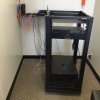I missed this post
you can do DIY cheaply than buy on the shelf...
you need time to learning and gathering sensors and brush out to learn lua programming or ESP8266 arduino style
cheap way: ESP8266 ( WIFI is included).
getting to know on i2c and spi are the key
if you need many I/O, Arduino still the best, I picked learning arduino for 2 weeks with getting familiar in sensor/control and hunting cheap clone arduino/sensor on ebay
if you are hate DIY, buying on the shelf is an alternate. ITwatchdogs is pretty solid device to do monitoring on my experience
Actually love DIY!
Problem is I lack time... and for most build outs I get something odd the shelf and pretty for clients. the IT watchdog LOOKS good and if it fails I can point to them, not the arduino I build in my basement.






